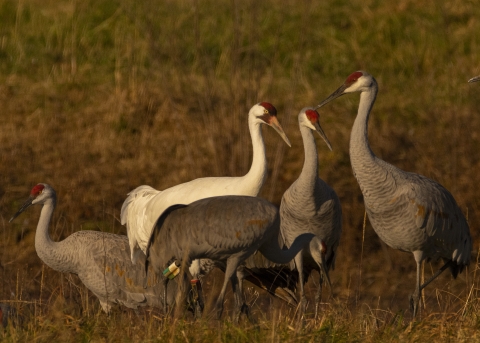Visit Us
National wildlife refuges provide an opportunity to unplug from the stresses of daily life and reconnect with our natural surroundings. We invite you to explore the unique prairie and wetland habitats found on Audubon National Wildlife Refuge. Both Lake Audubon and Lake Sakakawea were formed when the Garrison Dam was constructed on the Missouri River, creating an impressive area for waterfowl and other wildlife.
Location and Contact Information
- Audubon National Wildlife RefugeView Details3275 11th Street NW Coleharbor, ND 58531-9419
About Us
Audubon National Wildlife Refuge was established on May 25,1956. The Refuge was originally named Snake Creek National Wildlife Refuge for the creek that meandered through the valley that later became the bottom of Lake Audubon after the Garrison Dam was built on the Missouri River. The Refuge is an important feeding and resting area for waterfowl migrating in the Central Flyway. The Refuge provides grassland habitat for sparrows, sharp-tailed grouse, fox, coyote and white-tailed deer; wetland habitat for shorebirds, gulls, terns, rails, and cranes; and island habitat for nesting ducks and Canada geese. Restoration of the giant Canada goose was one of the earliest purposes along with mitigation for habitat lost when the Garrison Dam flooded Missouri River bottomlands.
Tours
The auto tour route takes you on a 8.5-mile drive along the south shore of Lake Audubon. Depending on the time of year, many species of birds, deer, small mammals, and the occasional moose may be seen along the route.
The Prairie Nature Trail is open year-round, although it is not maintained during the winter. Approximately one-half mile has a concrete surface and one-half mile is a gravel surface. The trailhead is located on the north side of the office and visitor center. Beginner skill level.
The North Country National Scenic Trail is a mowed path through the grassland and is open year-round. Approximately 13 miles of this trail is located on Audubon National Wildlife Refuge. Beginner-intermediate skill level, trail head near most Refuge entrances.
What We Do
Wildlife conservation is at the heart of the National Wildlife Refuge System. It drives everything on U.S. Fish and Wildlife Service lands and waters, from a national wildlife refuge national wildlife refuge
A national wildlife refuge is typically a contiguous area of land and water managed by the U.S. Fish and Wildlife Service for the conservation and, where appropriate, restoration of fish, wildlife and plant resources and their habitats for the benefit of present and future generations of Americans.
Learn more about national wildlife refuge ’s establishment, to the recreational activities offered, to the resource management tools used. The Refuge System uses the best conservation practices on service lands and waters to ensure the survival of native wildlife species. At Audubon National Wildlife Refuge that includes prescribed fire, cooperative haying and livestock grazing, water level management, and recreation management.
Our Species
The majestic flights of thousands of ducks, geese, sandhill cranes, and shorebirds are visible on the Refuge during spring and fall migration. Endangered whooping cranes are often seen migrating in small groups or with sandhill cranes. Piping plovers, a threatened species, nest in the area each summer. Giant Canada geese, in addition to ducks such as mallards, gadwalls, blue-winged teal, northern pintails, and lesser scaup, are common nesters on the Refuge.
Other birds you may see include northern harriers, marbled godwits, upland sandpipers, western meadowlarks, bobolinks, and more than 200 other species.
Audubon National Wildlife Refuge also provides habitat for wildlife that make the prairie their year-round home. White-tailed deer, coyote, red fox, sharp-tailed grouse, and gray partridge are some of the hardier species that are adapted to North Dakota's climate. The ring-necked pheasant is also a Refuge resident whose numbers often decline during severe winters.


















